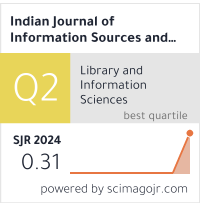Exploring the Relationship Between Academic Science and Economics Through Biofuel Research: A Scientometric Analysis
DOI:
https://doi.org/10.51983/ijiss-2024.14.1.4112Keywords:
Scientometric analysis, Biofuel, Research Productivity, Citation analysis, Research Trends, Vosviewer, VisualizationAbstract
Scientometrics is increasingly wielded as a powerful tool in shaping scientific policies, impacting the allocation of funding for projects and institutions by assessing priorities, viewpoints, and capabilities. The investigation of the relationship between academic science and economics is one of the most recent developments in the field of scientific metrics study. It assumes the role of an analysis method of knowledge production and dissemination in innovation systems. These results suggest that biofuel positively affected research collaboration and, as a result, scientific performance. HistCite is one of the study’s tools for analyzing data in a clear and concise manner. Manual searches were conducted on their websites to gather a condensed overview of their data for data mining purposes. Additionally, the Web of Science (WOS) database was utilized for research visualization. Vos Viewer and MS Excel were employed to create graph-like visualizations of data, particularly focusing on the key term 'biofuel' to showcase the field’s research focus and productivity rankings in this area. Statistical techniques and web mining were employed to refine and extract pertinent information. The study period was 33 years (1989-2022), and the results are presented in this paper. This may help to show that the continual growth of plants on our planet greatly outweighs men’s fundamental energy consumption when considering ecological, technical, and economic considerations; only a portion of the biomass that grows can be used to generate energy.
References
Aksnes, D. W., Langfeldt, L., & Wouters, P. (2019). Citations,citation indicators, and research quality: An overview of basicconcepts and theories. Sage Open, 9(1), 2158244019829575.
Anthony, D., Siriwardana, H., Ashvini, S., Pallewatta, S.,Samarasekara, S. M., Edirisinghe, S., & Vithanage, M. (2023).
Trends in marine pollution mitigation technologies: Scientometric analysis of published literature (1990-2022). Regional Studies in Marine Science, 103156.
Biswal, T., Shadangi, K. P., & Sarangi, P. K. (2023). Technologies ofMicroalgae Biomass Cultivation for Bio-Fuel Production: Challengesand Benefits. In Biorefinery Production of Fuels and PlatformChemicals, 147-178.
Chen, C., & Song, M. (2019). Visualizing a field of research: Amethodology of systematic scientometric reviews. PloS One, 14(10),e0223994.
Chen, C., Hu, Z., Liu, S., & Tseng, H. (2012). Emerging trends inregenerative medicine: A scientometric analysis in CiteSpace. Expert Opinion on Biological Therapy, 12(5), 593-608.
Cipresso, P., Giglioli, I. A. C., Raya, M. A., & Riva, G. (2018). Thepast, present, and future of virtual and augmented reality research: Anetwork and cluster analysis of the literature. Frontiers inPsychology, 2086.
Contandriopoulos, D., A. Duhoux, C. Larouche, & M. Perroux.(2016). The impact of a researcher’s structural position on scientificperformance: An empirical analysis. PLoS ONE, 11, e0161281.
Costas, R., & Bordons, M. (2007). The h-index: Advantages,limitations and its relation with other bibliometric indicators at themicro level. Journal of Informetrics, 1(3), 193-203.
Dietz, J., Chompalov, I., Bozeman, B., Lane, E., & Park, J. (2000).Using the curriculum vita to study the career paths of scientists andengineers: An exploratory assessment. Scientometrics, 49(3), 419-442.
Dragone, G., Fernande, B., Vicente, A. A., & Teixeira, J. A. (2010).Third generation biofuels from microalgae. In A. Mendez-Vilas (Ed.),Current Research, Technology and Education Topics in AppliedMicrobiology and Microbial Biotechnology (pp. 1355e66). Formatex.
Hakkarak, V. (2023). A Bibliometric Analysis of Journal ofScientometric Research Based on Dimensions Database. IndianJournal of Information Sources and Services, 13(1), 26-31.
Ivancheva, L. (2008). Scientometrics today: A methodologicaloverview. Collnet Journal of Scientometrics and InformationManagement, 2(2), 47-56.
Leech, D., Kavanagh, P., & Schuhmann, W. (2012). Enzymatic fuelcells: Recent progress. Electrochimica Acta, 84, 223-234.
Leydesdorff, L., & Milojević, S. (2012). Scientometrics. arXivpreprint arXiv:1208.4566.
Li, L., Huang, Z., Shu, F., Gao, Y., & Long, J. (2024).Hydrodeoxygenation of heavy lignin bio-oil to oxygenated fuelcatalyzed by CuxNiy/MgO. Fuel, 357, 129805.
Nasar, A., & Perveen, R. (2019). Applications of enzymatic biofuelcells in bioelectronic devices–A review. International Journal ofHydrogen Energy, 44(29), 15287-15312.
Nekoonam, A., Nasab, R. F., Jafari, S., Nikolaidis, T., Ebrahim, N.A., & Fashandi, S. A. M. (2023). A scientometric methodology basedon co-word analysis in gas turbine maintenance. Tehnički vjesnik,30(1), 361-372.
Qin, Y., Ghalambaz, M., Sheremet, M., Fteiti, M., & Alresheedi, F.(2023). A bibliometrics study of phase change materials (PCMs).Journal of Energy Storage, 73, 108987.
Shah, Y. R., & Sen, D. J. (2011). Bioalcohol as green energy: Areview. International Journal of Current Science Research, 01,57e62.
Voloshin, R. A., Kreslavski, V. D., Zharmukhamedov, S. K.,Bedbenov, V. S., Ramakrishna, S., & Allakhverdiev, S. I. (2015).Photoelectrochemical cells based on photosynthetic systems: Areview. Biofuel Research Journal, 6, 227e35.
Walkling, C. J., Zhang, D. D., & Harvey, B. G. (2024). Extended fuelproperties of sustainable aviation fuel blends derived from linalooland isoprene. Fuel, 356, 129554.
Downloads
Published
How to Cite
Issue
Section
License
Copyright (c) 2024 The Research Publication

This work is licensed under a Creative Commons Attribution-NonCommercial-NoDerivatives 4.0 International License.









